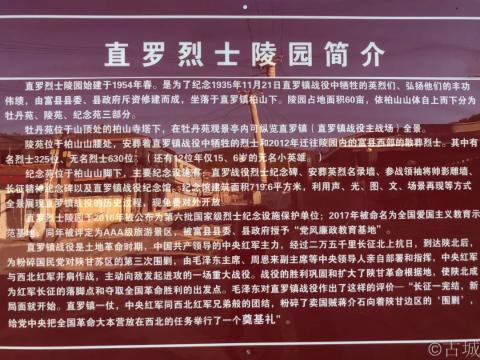
Day2 Shaanxi Hukou Waterfall-Zhiluo Town, Fuxian County, Yan'an City-Qingyang, Gansu Province, 400 kilometers, 4 hours
I originally wanted to eat when I came out of Hukou Waterfall, but I was wondering not to eat in the scenic area. As a result, I got on the highway as soon as I came out. I didn't get off the highway and went for a walk until I saw Zhiluo Town. It was almost 4 pm.
Zhiluo Town is affiliated to Fuxian County, Yan'an City. It was the site of the Zhiluo Battle in 1935. There is a martyrs cemetery in the town.

When I asked for directions, the local accent was completely northern Shaanxi. I ordered some glutinous rice noodles (a specialty of Shaanxi). It was chewy and I loved it. I tried the local specialty steam bowl, which is actually steaming meat and vegetables in a bowl. It feels average. I don't know if the restaurant we came to doesn't cook it well, or if it all tastes the same.
Arrive in the evening and stay in Qingyang, Gansu.
Day3 Qingyang, Gansu - Lanzhou - Ta'er Monastery in Xining, Qinghai, 712 kilometers, 9 hours
Qingyang is a relatively prosperous city, and the girl at the hotel front desk said that wages here are low and consumption is high. From where we live, we can see that the surrounding businesses are diverse and very popular.
Eat beef noodles at the nearby beef noodle restaurant at 9 a.m. I'm afraid beef noodles are only served for breakfast in Gansu, while other places only open at noon. The red oil here is not spicy, but fragrant, and the noodles are absolutely chewy and delicious! I never knew why Northwest noodles were so chewy before, but now that I have learned some pastry knowledge, I realize that it may be due to the high protein content.

Common sea bowl in the northwest

Massive?
Arrive at Kumbum Monastery in Xining, Qinghai at 5:30 in the afternoon. After the tourist peak, there are few people on the streets, and the lamas walk in groups.

evening street

I found many Qiuying flowers on the roadside and I liked them very much .

We randomly found a Muslim restaurant to eat. Having experienced the northwest, we didn’t expect that we couldn’t understand the dialect at all. Walking back to the hotel near Kumbum Monastery, I was a bit out of breath going uphill. It was the first time I entered the plateau, and the altitude of 2,600 meters was still a bit disturbing.
Day 4 Kumbum Temple
The Lianhuashan Hotel where we stayed is right next to Kumbum Monastery. It is clean and has heating during this season. For breakfast, I paid ten yuan for two eggs, which was very filling. The Tibetan landlady is always smiling and the kitchen is kept beautiful and tidy.

Walk to Kumbum Monastery at 8:30 in the morning to visit.

Lao Gu carrying a heavy load on the streets
Kumbum Monastery, also known as Pagoda'er Temple, is one of the six major monasteries of the Gelug Sect (Yellow Sect) of Tibetan Buddhism in China. It is the birthplace of Tsongkhapa, the founder of the Yellow Sect. It is located in Xining City, the capital of Qinghai Province. It was founded in the 12th year of Hongwu in the Ming Dynasty. year (1379). It is named after the Big Silver Pagoda built in the Dajinwa Temple to commemorate Tsongkhapa, the founder of the Yellow Sect. In Tibetan, it is called "Gun Ben Xian Balin", which means "Maitreya Temple with a hundred thousand lions roaring Buddha statues". Kumbum Monastery is the activity center of Tibetan Buddhism in northwest China and enjoys a high reputation in China and Southeast Asia. The central governments of all dynasties have highly praised the religious status of Kumbum Monastery. In the Ming Dynasty, the upper-level religious figures in the temple were granted many titles. Emperor Kangxi of the Qing Dynasty awarded the plaque "Jingshang Jinliang", Emperor Qianlong granted the title "Fanzong Temple", and the Dajinwa Temple was awarded the "Sanskrit Dharma Pillar" plaque. The Third Dalai Lama, the Fourth Dalai Lama, the Fifth Dalai Lama, the Seventh Dalai Lama, the Thirteenth Dalai Lama, the Fourteenth Dalai Lama and the Sixth, Ninth and Tenth Panchen Lama all performed at Kumbum Monastery. Celebrate religious activities. Butter flowers, murals and embroidery are known as the "Three Wonders of Kumbum Temple Art". In addition, the temple also collects many Buddhist classics and academic monographs on history, literature, philosophy, medicine, legislation and other aspects. (Excerpted from "Baidu")

Entrance to Kumbum Temple


Eight Treasures Ruyi Pagoda


Dajinwa Temple White Pagoda

Xiaojinwa Temple

monk's house


Great Sutra Hall


One of the four major scholastic schools

Tibetan Scripture Pavilion

School of Classical Debate
There are many people. I tried the electronic tour guide, but the effect was average and not vivid enough. I don’t know much about religion, which is a pity.
Next issue: Qinghai Lake and Chaka Salt Lake
